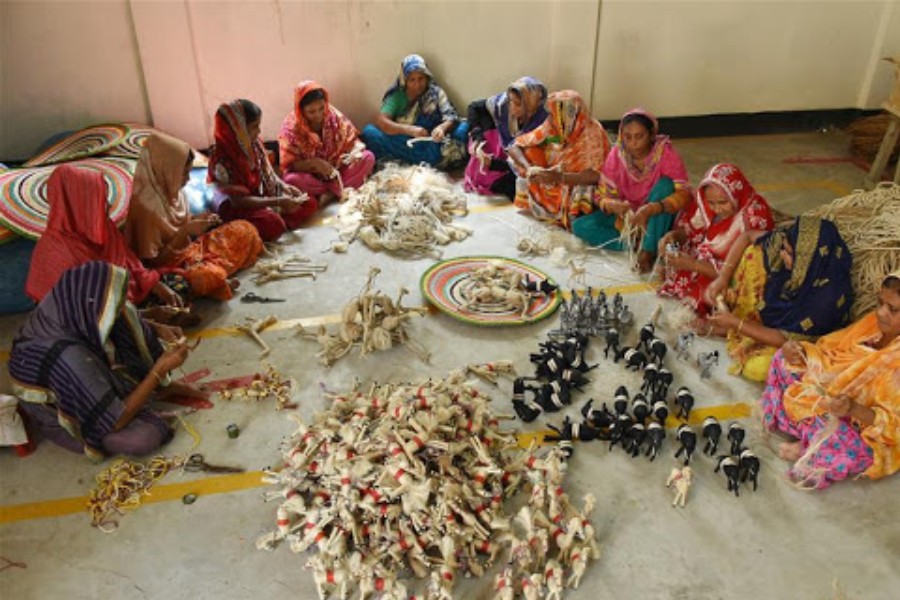Bangladesh's handicraft industry cannot flourish as per the expectations due to a lack of policy support, sector insiders said.
Although the demands for handcraft products have increased worldwide, the country's export volume has remained almost stagnant over the years, said the leaders of the industry, while talking to The Financial Express.
The local industry cannot compete in the international market in the absence of required raw materials, adequate artisans, essential design development mechanism, research works, infrastructures, and so forth, they mentioned.
Golam Ahsan, president of the Bangladesh Handicrafts Manufacturers and Exporters Association - commonly known as Banglacraft, said they were struggling this time around due to the impact of Covid-19 pandemic.
The production cost of per unit of handicraft items has increased 20 per cent, he said, but the prices of the products have not increased in the international market.
Asked, the Banglacraft president said buyers were asking the businesses to fulfil more compliance requirements.
Besides, the prices of raw materials and wages of workers have also increased in recent times. On the other hand, the production of essential natural raw materials like jute and hogla (elephant grass) has declined following floods last year.
All these lead to the increase in production cost, Ahsan explained.
Though handicraft is an industry rooted in traditions of the land, the sector is ignored in the country, he ventilated his frustration.
Meanwhile, China and Vietnam earn a huge currency from this sector. For example, Vietnam earns US$ 900 million a year from handicraft export, as per the Banglacraft.
On the other hand, Bangladesh earns about US$ 20 million each year from the export of handicraft products despite having a huge potential, said the association.
Asked how to bring qualitative changes in the sector, the association leaders said if they wanted to boost up earnings from handicraft export, the number of artisans needed to be increased to minimum 1.0 million from the existing 100,000.
In addition, design development centres and much-needed research work are needed to help the industry cope with the changing times.
But these facilities could not be ensured since Banglacraft's inception in 1979, they expressed their frustrations.
In the meantime, the export earnings from handicraft sector in the seven months of the current fiscal year (FY) 2020-21 have increased because of growing demand for environment-friendly products across the globe.
During the July-January period of the current fiscal year, handicraft exporters earned US$19.61 million, up by 48.22 per cent from the corresponding period of the last fiscal year, according to the data available from the Export Promotion Bureau (EPB). The sector earned US$ 13.23 million in the seven months of last FY.
The country earned $20.52 million during the FY 2019-20 and $19.95 million in FY 2018-19.
Referring to the global demands for handicraft products, Banglacraft president said handicrafts had become an essential part in different nations in Europe, America and Asia because of the environment-friendly features of the products.
Therefore, the demand for these products has increased even in the pandemic, since consumers in the developed countries now use green products for their daily life, he mentioned.
Despite the global demand, Bangladeshi handicraft export volume is not increasing, he lamented.
To achieve attractive earnings from this sector, Ahsan sought implementation of draft policy that was adopted in 2015.
Because of various complications, he said, the policy is yet to be executed.
Many useful recommendations were made in the draft policy like introducing a craft village, research and design development works, etc - implementation of those suggestions can change the handicraft industry for better, he said.
If the raw materials, including hogla and cane, are cultivated commercially, the scarcity of the essential ingredients for making handicraft items can be addressed, he opined, demanding the government support in this regard.
According to manufacturers, Bangladesh exports handicraft goods to over 50 countries like USA, German, France, Holland, Belgium, Spain, Japan, etc.
The exportable item comprises handmade attires, various items made with natural raw materials such as baskets, showpieces, terracotta, pottery and handmade carpets.


